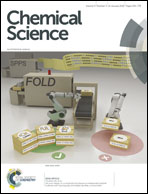Selective lithium ion recognition in self-assembled columnar liquid crystals based on a lithium receptor†
Abstract
Lithium is recognized as being significantly important due to its various applications in different areas especially in energy technology. In the present study, self-assembled nanostructured liquid-crystalline (LC) materials, that selectively bind lithium cations, have been developed for the first time. Wedge-shaped crown ether derivatives bearing dibenzo-14-crown-4 (DB14C4) or 12-crown-4 moieties are able to act as LC lithium-selective receptors. We have found that complexation of these receptors with lithium perchlorate induces liquid-crystalline columnar phases, while sodium perchlorate is immiscible with both receptors. Remarkably, a receptor consisting of DB14C4 as an effective lithium-selective ligand exhibits high selectivity for LiCl over NaCl, KCl, RbCl and CsCl. The lithium selectivity was demonstrated and investigated by 1H NMR, 1H COSY and FT-IR spectroscopic measurements. The preferred coordination number of four and the ideal cavity geometry of the DB14C4 moiety of the receptor are shown to be key factors for the high lithium selectivity. This new design of LC lithium-selective receptors opens unexplored paths for the development of methods to fabricate nanostructured materials for efficient selective lithium recognition.



 Please wait while we load your content...
Please wait while we load your content...